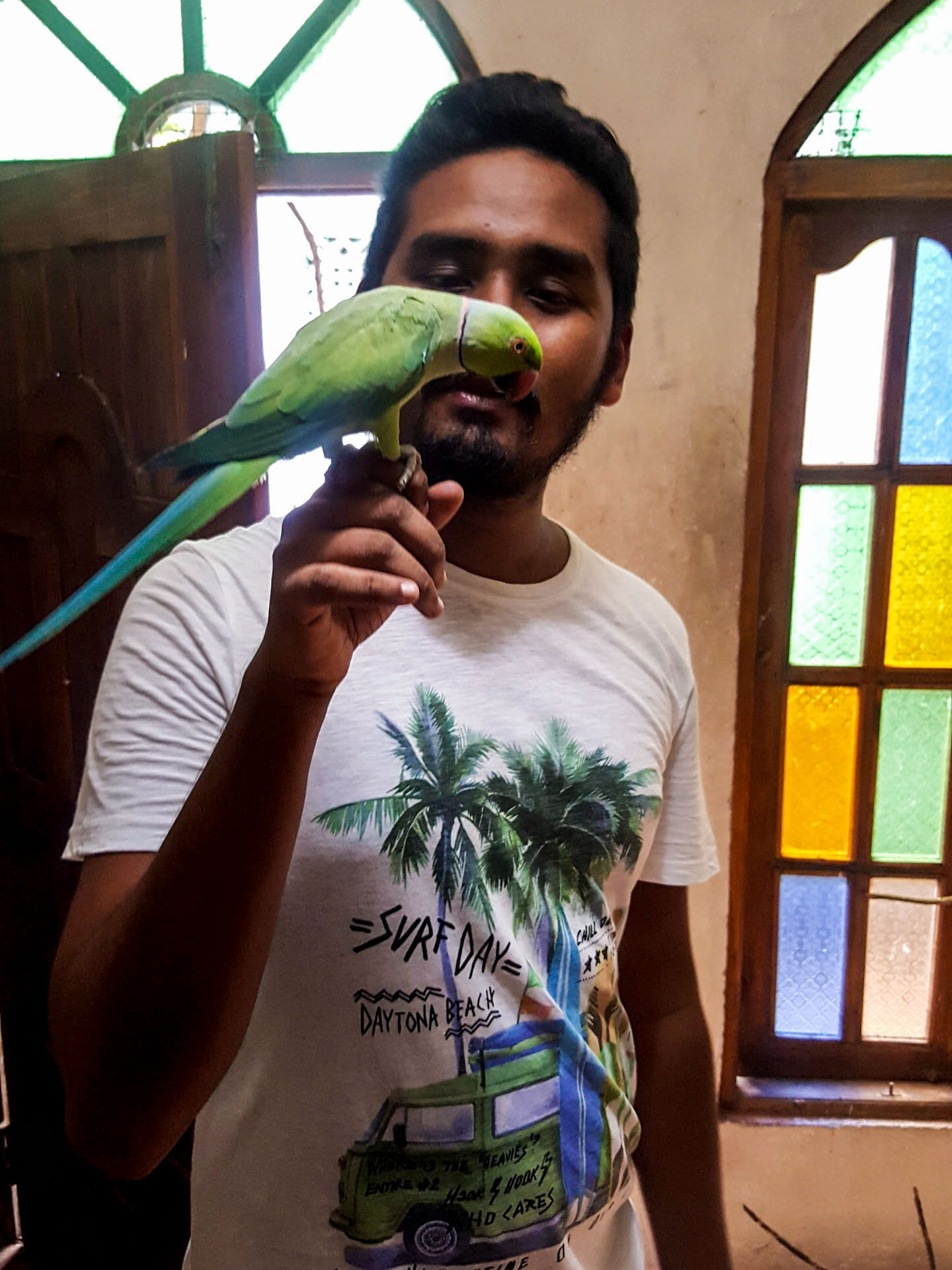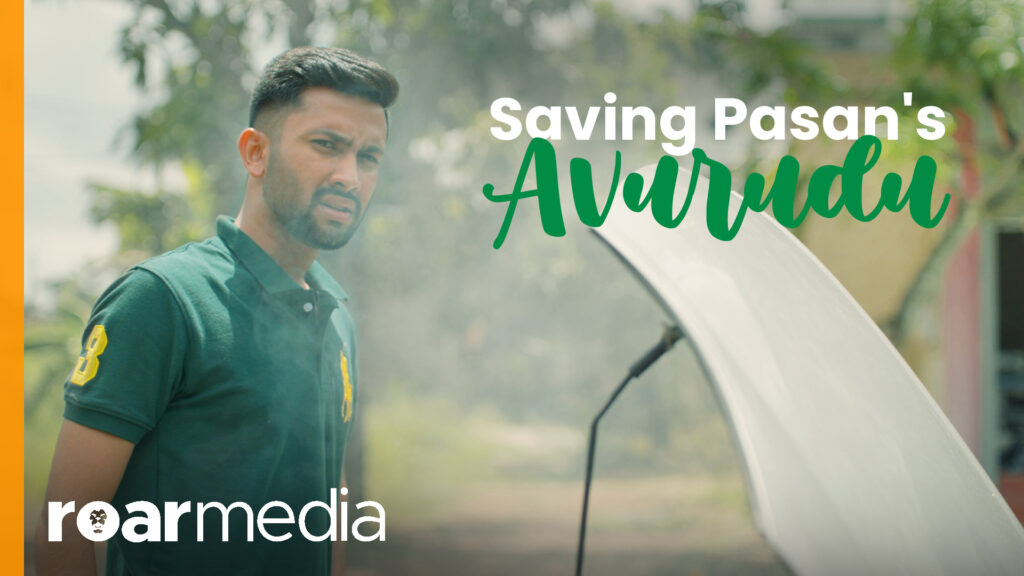With towering new hotels and luxury apartments taking over the skyline, a bird sanctuary is the last thing you would expect in Slave Island. Yet, this part of town is precisely that. Whenever an injured bird is spotted in the vicinity, the residents rescue it and pass it on to Firi Rahman, a well-known resident of the area.
Meet Firi: Bird Rescuer

An artist by profession, Firi Rahman, 28, divides his time between creating minutely detailed, hyper-realistic artwork, and looking after injured or juvenile birds and animals which find their way to him.
Thanks to a grandmother who loved parrots, Firi’s childhood was full of talkative birds. “I guess I got it [my love for birds] from her,” he says. “Even my dad is very supportive. He’s the one who gets them fruit most of the time.”
Rahman rescued his first bird when he was ten. It was a budgerigar that was born without a beak. Firi took it upon himself to ensure the bird survived, and learnt to eat—which it did.
From then on, his home doubled as a menagerie for not just birds, but baby squirrels and pregnant cats as well. His family is often supportive of his endeavors, except when they involve cats: his grandmother intensely dislikes felines, but tolerates them nonetheless.
The ground floor of his home is taken up by three large cages, two for new birds, and one for a moulting 16-year-old matriarch—his oldest and weakest girl. The other birds are former pets with clipped wings. They are also young, loud, and possessive, demanding his attention when they feel he is too distracted.
Engulfed by chirrups and squawks in his home, Firi hopes his neighbours have made peace with the cacophony, because as he says, “what many people don’t realise is that parrots are extremely loud creatures…and they are around for a very, very long time.”
As of now, Firi has seven parrots and a litter of newborn kittens—the most number of rescues he’s had at one go. He keeps those that are too old or injured to be released into the wild, and releases the rest once he thinks they are fit enough to survive. He also used to have baby squirrels, all of whom have been released since.

He points to two of his more recent additions, a young layard’s parakeet, and an alexandrine parrot. Both are extremely friendly and interactive, open to scritches and taking friendly nips as they groom him affectionately.
“These guys might go back to the wild in a couple of years,” he says. “They are a bit too young right now so I’m engaging with them, but over time,I’ll leave them alone a bit more, give them less attention, and try to lose touch.”
He doesn’t release parrots which have been caged and kept as pets throughout their life, as their chances of surviving in the wild are minimal. This is because they are likely to approach people, increasing the possibility of getting caged again.
Finding Fosters, and Creating an Aviary
Firi takes his commitment to his birds very seriously. “I never give my parrots to anyone anyway—because I need to make sure that if I do, they are fully committed to it,” he said. “People are like ‘oh, they are very cute’, but after a while they realise the birds get very loud and that they can’t deal with that. And then, people try to release them and think it’s a good idea. But what they don’t realise is that the birds won’t have enough skills to survive in the wild like that. You have to make sure they are able to adapt to a new environment.”
So far, he has released the birds in Malwana, mainly because of the abundance of fruit—especially rambutan—in the area. Releasing them isn’t always easy either: Firi finds himself in a dilemma when the birds are healthy, but become attached to each other or have started laying eggs. While this isn’t a frequent occurrence, it is something he is faced with every now and then.
“I was going to release two of the older ones in a few weeks, but then these two became really good friends, and one of them impregnated the other parrot…so they’re like one family and I don’t know if it’s right to let them go or not,” he said.
Intelligent and communicative, and gifted with extremely good interpersonal skills, the birds require a high degree of maintenance. If anyone expresses interest in taking them off his hands, Firi asks them a set of questions, the first one being what their lifestyle and homes are like.
“Is there space, how are you going to keep them? And then I ask what their working hours are [like]. If it’s an eight hour job, you can’t have them — the birds need attention and you need to feed them every few hours,” he emphasises..
Firi’s home does not have garden space for an aviary either. To make up for this, he has made a number of modifications. He has attached wire-netting around his balcony, placed a lot of potted plants in and around the house, and has a large dry branch in the room leading to the balcony, so that when the door is left open, the birds have no dearth of things to perch on.
The older birds awaiting release are kept in the balcony with minimal contact, whereas the two younger rescues are on the ground floor. They aren’t usually caged, unless there are visitors or the doors or windows are opened.
Completely against the concept of caging—unless it’s for recuperation—he discourages people from actively seeking out baby birds for training.
“If someone’s looking for a baby, I’m assuming they’re getting it from the wild,” he said. “What I usually do is, I release my birds back into the wild once they’re fully recovered. I don’t want to release them in the city where they can land among people—where they’ll be stuck in an urban jungle and all that. I want them to be as wild as possible, have a partner, and live their own life.”








